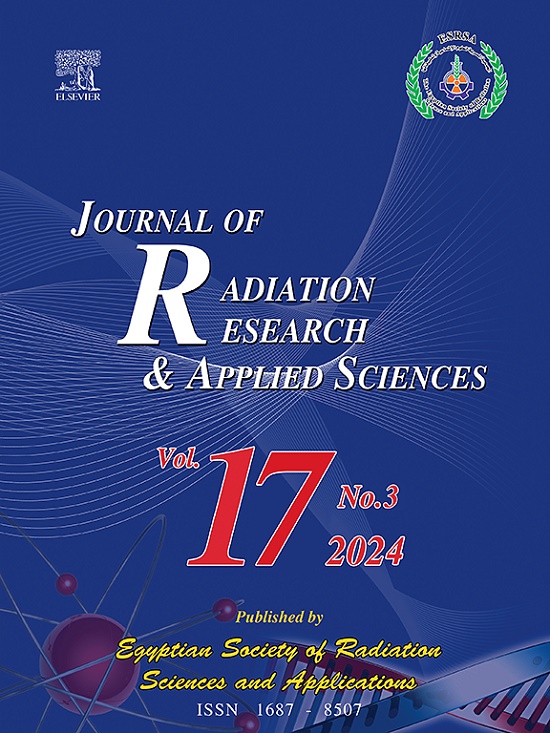基于Taguchi-GRA-PCA的三杂化卡森纳米流体在二次速度拉伸片上的传热性能优化
IF 1.7
4区 综合性期刊
Q2 MULTIDISCIPLINARY SCIENCES
Journal of Radiation Research and Applied Sciences
Pub Date : 2025-05-08
DOI:10.1016/j.jrras.2025.101570
引用次数: 0
摘要
在各种技术和商业应用中对有效传热流体的需求导致了对纳米流体的广泛研究。纳米流体的独特属性是比其他传统流体具有更好的导热性,使其成为改善热系统功能的一个有吸引力的选择。本研究采用计算方法,利用不可压缩、导电的三杂交纳米流体(THNF)在拉伸/收缩表面上研究二维稳定磁流体力学(MHD)流动。流体沿着可以膨胀或收缩的平面流动,并且可以以弯曲的方式改变其速度。我们认为表面速度是二次形式uw(x)=ax+bx2。本文旨在分析磁场作用下THNF流动中的换热问题。研究了收缩/拉伸参数λ、吸注参数S、卡森流体参数β和磁性参数m等控制因素对流动场和热场的影响,将控制偏微分方程(PDEs)转化为常微分方程(ODEs)进行数值求解。我们还利用灰色关联分析(GRA)和主成分分析(PCA)来优化响应函数,利用物理参数{λ,β,M,Rd}值的最佳组合。结果表明:随着拉伸参数λ∈{0.1,0.4,0.7,1}的增大,速度剖面(f′(η))得到改善;研究还发现,Taguchi-GRA方法和Taguchi-GRA- pca方法都能识别出相同的理想参数集。确定的最佳参数组合为{λ4,β1,M4,Rd2}。本文章由计算机程序翻译,如有差异,请以英文原文为准。
Integrated Taguchi-GRA-PCA for optimizing the heat transfer performance of trihybrid Casson nanofluid flow over stretching sheet with quadratic velocity
The necessity for effective heat transfer fluids in various technical and business applications has resulted in extensive study into nanofluids. Nanofluids' unique attribute is significantly better thermal conductivity than other conventional fluids, making them an appealing option for improving thermal system functionality. This study uses computational methods to investigate a two-dimensional steady magneto-hydrodynamics (MHD) flow using an incompressible, electrically conducting trihybrid nanofluid (THNF) across a stretching/shrinking surface. The fluid flows along a flat surface that can either expand or contract and can modify its speed in a curved way. We considered surface velocity to be in quadratic form . The work aims to analyze the heat transfer in the THNF flow subjected to the magnetic field. The study examined the effects on the flow and thermal fields of the governing factors, which include the shrinking/stretching parameter , suction/injection parameter , Casson fluid parameter and magnetic parameter . The governing partial differential equations (PDEs) are converted into ordinary differential equations (ODEs) and then solved numerically. We have also utilized Grey Relational Analysis (GRA) and Principal Component Analysis (PCA) to optimize the response function by utilizing the best combination of the values of physical parameters . The results show that with the increase in the stretching parameter , the velocity profile got improved. The study also revealed that both the Taguchi-GRA and Taguchi-GRA-PCA methods identified the same ideal parameter set. The best parameters combination identified is .
求助全文
通过发布文献求助,成功后即可免费获取论文全文。
去求助
来源期刊

Journal of Radiation Research and Applied Sciences
MULTIDISCIPLINARY SCIENCES-
自引率
5.90%
发文量
130
审稿时长
16 weeks
期刊介绍:
Journal of Radiation Research and Applied Sciences provides a high quality medium for the publication of substantial, original and scientific and technological papers on the development and applications of nuclear, radiation and isotopes in biology, medicine, drugs, biochemistry, microbiology, agriculture, entomology, food technology, chemistry, physics, solid states, engineering, environmental and applied sciences.
 求助内容:
求助内容: 应助结果提醒方式:
应助结果提醒方式:


